|
|
|

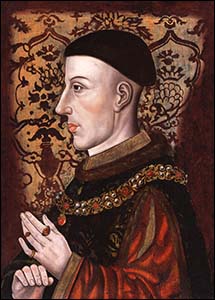
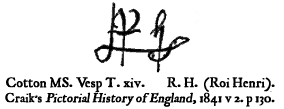
HENRY V, King of England, son of King Henry IV by Mary de Bohun, was born at Monmouth, in August 1387. On his father's exile in
1398, Richard II took the boy into his own charge, and treated him kindly.
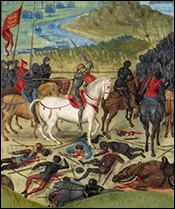 Next year the Lancastrian revolution forced Henry into precocious prominence as heir to the throne. From October 1400 the administration of Wales was conducted in his name;
less than three years later he was in actual command of the English forces and fought against the Percies at
Shrewsbury. The Welsh revolt absorbed his energies till 1408. Then through the king's ill-health he began to take a wider share in politics. From
January 1410, helped by his uncles Henry Beaufort and Thomas Beaufort, he had practical control of the government.
Both in foreign and domestic policy he differed from the king, who in November 1411 discharged the prince from the council.
Next year the Lancastrian revolution forced Henry into precocious prominence as heir to the throne. From October 1400 the administration of Wales was conducted in his name;
less than three years later he was in actual command of the English forces and fought against the Percies at
Shrewsbury. The Welsh revolt absorbed his energies till 1408. Then through the king's ill-health he began to take a wider share in politics. From
January 1410, helped by his uncles Henry Beaufort and Thomas Beaufort, he had practical control of the government.
Both in foreign and domestic policy he differed from the king, who in November 1411 discharged the prince from the council.
The quarrel of father and son was political only, though it is probable that the Beauforts had discussed the abdication of King Henry IV, and
their opponents certainly endeavoured to defame the prince. It may be that to political enmity the tradition of Henry's riotous youth, immortalized by Shakespeare, is partly due.
To that tradition Henry's strenuous life in war and politics is a sufficient general contradiction. The most famous incident, his quarrel with the chief justice, has no contemporary
authority and was first related by Sir Thomas Elyot in 1531. The story of Falstaff originated partly in Henry's early friendship for Oldcastle. That friendship, and the prince's political
opposition to Archbishop Arundel, perhaps encouraged Lollard hopes. If so, their disappointment may account for the statements of ecclesiastical writers,
like Walsingham, that Henry on becoming king was changed suddenly into a new man.
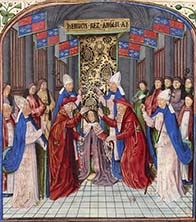 Henry succeeded his father on the 20th of March 1413. With no past to embarrass him, and with no dangerous rivals, his practical experience had full scope. He had to deal with three main
problems — the restoration of domestic peace, the healing of schism in the Church and the recovery of English prestige in Europe. Henry grasped them all together, and gradually built
upon them a yet wider policy. From the first he made it clear that he would rule England as the head of a united nation, and that past differences were to be forgotten.
Richard II was honourably reinterred; the young Mortimer was taken into favour; the heirs of those who had suffered in the last reign
were restored gradually to their titles and estates. With Oldcastle Henry used his personal influence in vain, and the gravest domestic danger was Lollard discontent. But the king's firmness
nipped the movement in the bud (Jan. 1414), and made his own position as ruler secure. Save for the abortive Scrope and
Cambridge plot in favour of Mortimer in July 1415, the rest of his reign was free
from serious trouble at home. Henry could now turn his attention to foreign affairs.
Henry succeeded his father on the 20th of March 1413. With no past to embarrass him, and with no dangerous rivals, his practical experience had full scope. He had to deal with three main
problems — the restoration of domestic peace, the healing of schism in the Church and the recovery of English prestige in Europe. Henry grasped them all together, and gradually built
upon them a yet wider policy. From the first he made it clear that he would rule England as the head of a united nation, and that past differences were to be forgotten.
Richard II was honourably reinterred; the young Mortimer was taken into favour; the heirs of those who had suffered in the last reign
were restored gradually to their titles and estates. With Oldcastle Henry used his personal influence in vain, and the gravest domestic danger was Lollard discontent. But the king's firmness
nipped the movement in the bud (Jan. 1414), and made his own position as ruler secure. Save for the abortive Scrope and
Cambridge plot in favour of Mortimer in July 1415, the rest of his reign was free
from serious trouble at home. Henry could now turn his attention to foreign affairs.
A writer of the next generation was the first to allege that Henry was encouraged by ecclesiastical statesmen to enter on the French war as a means of diverting attention from home troubles.
For this story there is no foundation. The restoration of domestic peace was the king's first care, and until it was assured he could not embark on any wider enterprise abroad. Nor was that
enterprise one of idle conquest. Old commercial disputes and the support which the French had lent to Glendower gave a sufficient excuse for war, whilst the
disordered state of France afforded no security for peace. Henry may have regarded the assertion of his own claims as part of his kingly duty, but in any case a permanent settlement of the
national quarrel was essential to the success of his world policy.
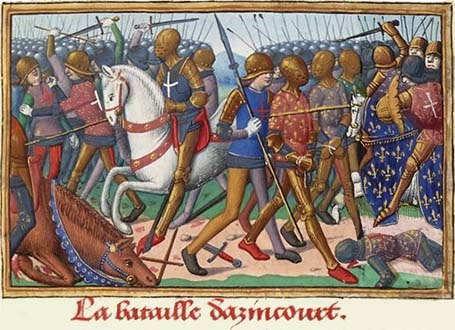
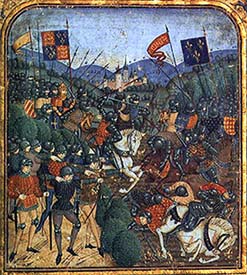
The campaign of 1415, with its brilliant conclusion
at Agincourt (October 25), was only the first step. Two years of patient preparation followed. The command of the sea was secured by driving the Genoese allies of the French out of the Channel.
A successful diplomacy detached the emperor Sigismund from France, and by the Treaty of Canterbury paved the way to end the schism in the Church. So in 1417 the war was renewed on a larger scale.
Lower Normandy was quickly conquered, Rouen cut off from Paris and besieged. The French were paralysed by the disputes of Burgundians and Armagnacs. Henry skilfully played them off one against
the other, without relaxing his warlike energy.
 In January 1419
Rouen fell. By August the English were outside the walls of Paris. The intrigues of the French parties culminated in the assassination of John of Burgundy by the dauphin's partisans at
Montereau (September 10, 1419). Philip, the new duke, and the French court threw themselves into Henry's arms. After six months' negotiation Henry was by the Treaty of Troyes recognized
as heir and regent of France, and on the 2nd of June 1420 married Catherine, the king's daughter. He was now at the height of his power. His eventual
success in France seemed certain. In January 1419
Rouen fell. By August the English were outside the walls of Paris. The intrigues of the French parties culminated in the assassination of John of Burgundy by the dauphin's partisans at
Montereau (September 10, 1419). Philip, the new duke, and the French court threw themselves into Henry's arms. After six months' negotiation Henry was by the Treaty of Troyes recognized
as heir and regent of France, and on the 2nd of June 1420 married Catherine, the king's daughter. He was now at the height of his power. His eventual
success in France seemed certain.
He shared with Sigismund the credit of having ended the Great Schism by obtaining the election of Pope Martin V. All the states of western Europe were being brought within the web of
his diplomacy. The headship of Christendom was in his grasp, and schemes for a new crusade began to take shape. He actually sent an envoy to collect information in the East; but his
plans were cut short by death. A visit to England in 1421 was interrupted by the defeat of Clarence at Bauge.
The hardships of the longer winter siege of Meaux broke down his health, and he died at Bois de Vincennes on the 31st of August 1422.
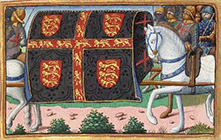 Henry's last words were a wish that he might live to rebuild the walls of Jerusalem. They are significant. His ideal was founded consciously on the models of Arthur and Godfrey as
national king and leader of Christendom. So he is the typical medieval hero. For that very reason his schemes were doomed to end in disaster, since the time was come for a new departure.
Yet he was not reactionary. His policy was constructive: a firm central government supported by parliament; church reform on conservative lines; commercial development; and the maintenance
of national prestige. His aims in some respects anticipated those of his Tudor successors, but he would have accomplished them on medieval lines as a constitutional ruler. His success was
due to the power of his personality. He could train able lieutenants, but at his death there was no one who could take his place as leader. War, diplomacy and civil administration were
all dependent on his guidance. His dazzling achievements as a general have obscured his more sober qualities as a ruler, and even the sound strategy, with which he aimed to be master of
the narrow seas. If he was not the founder of the English navy he was one of the first to realize its true importance.
Henry's last words were a wish that he might live to rebuild the walls of Jerusalem. They are significant. His ideal was founded consciously on the models of Arthur and Godfrey as
national king and leader of Christendom. So he is the typical medieval hero. For that very reason his schemes were doomed to end in disaster, since the time was come for a new departure.
Yet he was not reactionary. His policy was constructive: a firm central government supported by parliament; church reform on conservative lines; commercial development; and the maintenance
of national prestige. His aims in some respects anticipated those of his Tudor successors, but he would have accomplished them on medieval lines as a constitutional ruler. His success was
due to the power of his personality. He could train able lieutenants, but at his death there was no one who could take his place as leader. War, diplomacy and civil administration were
all dependent on his guidance. His dazzling achievements as a general have obscured his more sober qualities as a ruler, and even the sound strategy, with which he aimed to be master of
the narrow seas. If he was not the founder of the English navy he was one of the first to realize its true importance.
Henry had so high a sense of his own rights that he was merciless to disloyalty. But he was scrupulous of the rights of others, and it was his eager desire to further the cause of
justice that impressed his French contemporaries. He has been charged with cruelty as a religious persecutor; but in fact he had as prince opposed the harsh policy of Archbishop Arundel,
and as king sanctioned a more moderate course. Lollard executions during his reign had more often a political than a religious reason. To be just with sternness was in his eyes a duty.
So in his warfare, though he kept strict discipline and allowed no wanton violence, he treated severely all who had in his opinion transgressed. In his personal conduct he was chaste,
temperate and sincerely pious. He delighted in sport and all manly exercises. At the same time he was cultured, with a taste for literature, art and music. Henry lies buried in
Westminster Abbey. His tomb was stripped of its splendid adornment during the Reformation.
(C. L. Kingsford)
Excerpted from:
Encyclopedia Britannica, 11th Ed. Vol XIII.
Cambridge: Cambridge University Press, 1910. 278.
Other Local Resources:
- The Battle of Agincourt
- The Agincourt Carol, on the Victory at Agincourt
- Shakespeare's Henry V
- House of Lancaster
- King Henry IV
- King Henry VI
- Catherine of Valois
- John, Duke of Bedford
- Humphrey, Duke of Gloucester
Images
- Henry V as a Boy
- Henry of Monmouth Knighted by Richard II, c1401-5
- Henry V as Prince of Wales from a Hoccleve MS
- Henry V portrait in an Illuminated Manuscript, c.1451-1480
- Coronation of Henry V, c1470-80
- Marriage of Henry V and Catherine of France, c1470-80
- Marriage of Henry V and Catherine of Valois, c1487
- Marriage of Henry V and Catherine of France, c1480
- Marriage of Henry V and Catherine by John Rous, c1485
- Henry V and his Court
- Henry V and his Army
- The Battle of Azincourt
- The Battle of Agincourt
- The King of England receiving the French herald, c.1485
- The Funeral Procession of Henry V
- Tomb of Henry V in Westminster Abbey
- Later Engraving of Henry V
- Helmet, Saddle, and Shield of Henry V
- The Great Seal of King Henry V
- Henry V's Coinage (Noble, Half Noble, Quarter Noble)
- Henry V's Coinage (Groat, Half Groat, Penny)
Books for further study:
Allmand, Christopher. Yale English Monarchs - Henry V.
Yale University Press, 1997.
Barker, Julie. Agincourt: Henry V and the Battle That Made England.
Little, Brown & Co., 2006.
Knight, Paul. Henry V and the Conquest of France 1416-53.
Osprey Publishing, 1998.
Mercer, Malcolm. Henry V: The Rebirth of Chivalry.
National Archives, 2006.
Shakespeare, William. Henry V.
Folger Shakespeare Library, 2004.
Thibodeau, Timothy M. Henry V, Holy Warrior.
McFarland, 2022.
Vale, Malcolm. Henry V: The Conscience of a King.
Yale University Press, 2016.
Henry V on the Web:
 | to King Henry IV
|
 | Hundred Years' War
|
 | to Luminarium Encyclopedia |
Site ©1996-2022 Anniina Jokinen. All rights reserved.
This page was created on April 19, 2007. Last updated October 10, 2022.
|
Index of Encyclopedia Entries:
Medieval Cosmology
Prices of Items in Medieval England
Edward II
Isabella of France, Queen of England
Piers Gaveston
Thomas of Brotherton, E. of Norfolk
Edmund of Woodstock, E. of Kent
Thomas, Earl of Lancaster
Henry of Lancaster, Earl of Lancaster
Henry of Grosmont, Duke of Lancaster
Roger Mortimer, Earl of March
Hugh le Despenser the Younger
Bartholomew, Lord Burghersh, elder
Hundred Years' War (1337-1453)
Edward III
Philippa of Hainault, Queen of England
Edward, Black Prince of Wales
John of Eltham, Earl of Cornwall
The Battle of Crécy, 1346
The Siege of Calais, 1346-7
The Battle of Poitiers, 1356
Lionel of Antwerp, Duke of Clarence
John of Gaunt, Duke of Lancaster
Edmund of Langley, Duke of York
Thomas of Woodstock, Gloucester
Richard of York, E. of Cambridge
Richard Fitzalan, 3. Earl of Arundel
Roger Mortimer, 2nd Earl of March
The Good Parliament, 1376
Richard II
The Peasants' Revolt, 1381
Lords Appellant, 1388
Richard Fitzalan, 4. Earl of Arundel
Archbishop Thomas Arundel
Thomas de Beauchamp, E. Warwick
Robert de Vere, Earl of Oxford
Ralph Neville, E. of Westmorland
Thomas Mowbray, Duke of Norfolk
Edmund Mortimer, 3. Earl of March
Roger Mortimer, 4. Earl of March
John Holland, Duke of Exeter
Michael de la Pole, E. Suffolk
Hugh de Stafford, 2. E. Stafford
Henry IV
Edward, Duke of York
Edmund Mortimer, 5. Earl of March
Henry Percy, Earl of Northumberland
Sir Henry Percy, "Harry Hotspur"
Thomas Percy, Earl of Worcester
Owen Glendower
The Battle of Shrewsbury, 1403
Archbishop Richard Scrope
Thomas Mowbray, 3. E. Nottingham
John Mowbray, 2. Duke of Norfolk
Thomas Fitzalan, 5. Earl of Arundel
Henry V
Thomas, Duke of Clarence
John, Duke of Bedford
Humphrey, Duke of Gloucester
John Talbot, Earl of Shrewsbury
Richard, Earl of Cambridge
Henry, Baron Scrope of Masham
William de la Pole, Duke of Suffolk
Thomas Montacute, E. Salisbury
Richard Beauchamp, E. of Warwick
Henry Beauchamp, Duke of Warwick
Thomas Beaufort, Duke of Exeter
Cardinal Henry Beaufort
John Beaufort, Earl of Somerset
Sir John Fastolf
John Holland, 2. Duke of Exeter
Archbishop John Stafford
Archbishop John Kemp
Catherine of Valois
Owen Tudor
John Fitzalan, 7. Earl of Arundel
John, Lord Tiptoft
Charles VII, King of France
Joan of Arc
Louis XI, King of France
Charles the Bold, Duke of Burgundy
The Battle of Agincourt, 1415
The Battle of Castillon, 1453
The Wars of the Roses 1455-1485
Causes of the Wars of the Roses
The House of Lancaster
The House of York
The House of Beaufort
The House of Neville
The First Battle of St. Albans, 1455
The Battle of Blore Heath, 1459
The Rout of Ludford, 1459
The Battle of Northampton, 1460
The Battle of Wakefield, 1460
The Battle of Mortimer's Cross, 1461
The 2nd Battle of St. Albans, 1461
The Battle of Towton, 1461
The Battle of Hedgeley Moor, 1464
The Battle of Hexham, 1464
The Battle of Edgecote, 1469
The Battle of Losecoat Field, 1470
The Battle of Barnet, 1471
The Battle of Tewkesbury, 1471
The Treaty of Pecquigny, 1475
The Battle of Bosworth Field, 1485
The Battle of Stoke Field, 1487
Henry VI
Margaret of Anjou
Richard Plantagenet, Duke of York
Edward IV
Elizabeth Woodville
Richard Woodville, 1. Earl Rivers
Anthony Woodville, 2. Earl Rivers
Jane Shore
Edward V
Richard III
George, Duke of Clarence
Ralph Neville, 2. Earl of Westmorland
Richard Neville, Earl of Salisbury
Richard Neville, Earl of Warwick
Edward Neville, Baron Bergavenny
William Neville, Lord Fauconberg
Robert Neville, Bishop of Salisbury
John Neville, Marquis of Montagu
George Neville, Archbishop of York
John Beaufort, 1. Duke Somerset
Edmund Beaufort, 2. Duke Somerset
Henry Beaufort, 3. Duke of Somerset
Edmund Beaufort, 4. Duke Somerset
Margaret Beaufort
Edmund Tudor, Earl of Richmond
Jasper Tudor, Earl of Pembroke
Humphrey Stafford, D. Buckingham
Henry Stafford, Duke of Buckingham
Humphrey Stafford, E. of Devon
Thomas, Lord Stanley, Earl of Derby
Sir William Stanley
Archbishop Thomas Bourchier
Henry Bourchier, Earl of Essex
John Mowbray, 3. Duke of Norfolk
John Mowbray, 4. Duke of Norfolk
John Howard, Duke of Norfolk
Henry Percy, 2. E. Northumberland
Henry Percy, 3. E. Northumberland
Henry Percy, 4. E. Northumberland
William, Lord Hastings
Henry Holland, Duke of Exeter
William Fitzalan, Earl of Arundel
William Herbert, 1. Earl of Pembroke
John de Vere, 12th Earl of Oxford
John de Vere, 13th Earl of Oxford
Thomas de Clifford, 8. Baron Clifford
John de Clifford, 9. Baron Clifford
John Tiptoft, Earl of Worcester
Thomas Grey, 1. Marquis Dorset
Sir Andrew Trollop
Archbishop John Morton
Edward Plantagenet, E. of Warwick
John Talbot, 2. E. Shrewsbury
John Talbot, 3. E. Shrewsbury
John de la Pole, 2. Duke of Suffolk
John de la Pole, E. of Lincoln
Edmund de la Pole, E. of Suffolk
Richard de la Pole
John Sutton, Baron Dudley
James Butler, 5. Earl of Ormonde
Sir James Tyrell
Edmund Grey, first Earl of Kent
George Grey, 2nd Earl of Kent
John, 5th Baron Scrope of Bolton
James Touchet, 7th Baron Audley
Walter Blount, Lord Mountjoy
Robert Hungerford, Lord Moleyns
Thomas, Lord Scales
John, Lord Lovel and Holand
Francis Lovell, Viscount Lovell
Sir Richard Ratcliffe
William Catesby
Ralph, 4th Lord Cromwell
Jack Cade's Rebellion, 1450
Tudor Period
King Henry VII
Queen Elizabeth of York
Arthur, Prince of Wales
Lambert Simnel
Perkin Warbeck
The Battle of Blackheath, 1497
King Ferdinand II of Aragon
Queen Isabella of Castile
Maximilian I, Holy Roman Emperor
King Henry VIII
Queen Catherine of Aragon
Queen Anne Boleyn
Queen Jane Seymour
Queen Anne of Cleves
Queen Catherine Howard
Queen Katherine Parr
King Edward VI
Queen Mary I
Queen Elizabeth I
Henry Fitzroy, Duke of Richmond
Margaret Tudor, Queen of Scotland
James IV, King of Scotland
The Battle of Flodden Field, 1513
James V, King of Scotland
Mary of Guise, Queen of Scotland
Mary Tudor, Queen of France
Louis XII, King of France
Francis I, King of France
The Battle of the Spurs, 1513
Field of the Cloth of Gold, 1520
Charles V, Holy Roman Emperor
Eustace Chapuys, Imperial Ambassador
The Siege of Boulogne, 1544
Cardinal Thomas Wolsey
Archbishop Thomas Cranmer
Thomas Cromwell, Earl of Essex
Thomas, Lord Audley
Thomas Wriothesley, E. Southampton
Sir Richard Rich
Edward Stafford, D. of Buckingham
Thomas Howard, 2nd Duke of Norfolk
Thomas Howard, 3rd Duke of Norfolk
John Dudley, Duke of Northumberland
Charles Brandon, Duke of Suffolk
Thomas Boleyn, Earl of Wiltshire
George Boleyn, Viscount Rochford
John Russell, Earl of Bedford
Thomas Grey, 2. Marquis of Dorset
Henry Grey, D. of Suffolk
Charles Somerset, Earl of Worcester
George Talbot, 4. E. Shrewsbury
Francis Talbot, 5. E. Shrewsbury
Henry Algernon Percy,
5th Earl of Northumberland
Henry Algernon Percy,
6th Earl of Northumberland
Ralph Neville, 4. E. Westmorland
Henry Neville, 5. E. Westmorland
William Paulet, Marquis of Winchester
Sir Francis Bryan
Sir Nicholas Carew
John de Vere, 15th Earl of Oxford
John de Vere, 16th Earl of Oxford
Thomas Seymour, Lord Admiral
Edward Seymour, Protector Somerset
Margaret Pole, Countess of Salisbury
Henry Pole, Lord Montague
Sir Geoffrey Pole
Thomas Manners, Earl of Rutland
Henry Manners, Earl of Rutland
Henry Bourchier, 2. Earl of Essex
Robert Radcliffe, 1. Earl of Sussex
Henry Radcliffe, 2. Earl of Sussex
George Hastings, Earl of Huntingdon
Henry Courtenay, Marquis of Exeter
George Neville, Baron Bergavenny
Sir Edward Neville
William, Lord Paget
William Sandys, Baron Sandys
William Fitzwilliam, E. Southampton
Sir Anthony Browne
Sir Thomas Wriothesley
Sir William Kingston
George Brooke, Lord Cobham
Sir Richard Southwell
Thomas Fiennes, 9th Lord Dacre
Sir Francis Weston
Henry Norris
Lady Jane Grey
Sir Thomas Arundel
Sir Richard Sackville
Sir William Petre
Sir John Cheke
Walter Haddon, L.L.D
Sir Peter Carew
Sir John Mason
Nicholas Wotton
John Taylor
Sir Thomas Wyatt, the Younger
Cardinal Lorenzo Campeggio
Cardinal Reginald Pole
Stephen Gardiner, Bishop of Winchester
Edmund Bonner, Bishop of London
Nicholas Ridley, Bishop of London
John Hooper, Bishop of Gloucester
John Aylmer, Bishop of London
Thomas Linacre
William Grocyn
Archbishop William Warham
Cuthbert Tunstall, Bishop of Durham
Richard Fox, Bishop of Winchester
Edward Fox, Bishop of Hereford
Pope Julius II
Pope Leo X
Pope Clement VII
Pope Paul III
Pope Pius V
Pico della Mirandola
Desiderius Erasmus
Martin Bucer
Richard Pace
Christopher Saint-German
Thomas Tallis
Elizabeth Barton, the Nun of Kent
Hans Holbein, the Younger
The Sweating Sickness
Dissolution of the Monasteries
Pilgrimage of Grace, 1536
Robert Aske
Anne Askew
Lord Thomas Darcy
Sir Robert Constable
Oath of Supremacy
The Act of Supremacy, 1534
The First Act of Succession, 1534
The Third Act of Succession, 1544
The Ten Articles, 1536
The Six Articles, 1539
The Second Statute of Repeal, 1555
The Act of Supremacy, 1559
Articles Touching Preachers, 1583
Queen Elizabeth I
William Cecil, Lord Burghley
Robert Cecil, 1st Earl of Salisbury
Sir Francis Walsingham
Sir Nicholas Bacon
Sir Thomas Bromley
Robert Dudley, Earl of Leicester
Ambrose Dudley, Earl of Warwick
Henry Carey, Lord Hunsdon
Sir Thomas Egerton, Viscount Brackley
Sir Francis Knollys
Katherine "Kat" Ashley
Lettice Knollys, Countess of Leicester
George Talbot, 6. E. of Shrewsbury
Elizabeth, Countess of Shrewsbury
Gilbert Talbot, 7. E. of Shrewsbury
Sir Henry Sidney
Sir Robert Sidney
Archbishop Matthew Parker
Walter Devereux, 1st Earl of Essex
Robert Devereux, 2nd Earl of Essex
Penelope Devereux, Lady Rich
Sir Christopher Hatton
Edward Courtenay, E. Devonshire
Edward Manners, 3rd Earl of Rutland
Thomas Radcliffe, 3. Earl of Sussex
Henry Radcliffe, 4. Earl of Sussex
Robert Radcliffe, 5. Earl of Sussex
William Parr, Marquis of Northampton
Henry Wriothesley, 2. Southampton
Henry Wriothesley, 3. Southampton
Charles Neville, 6. E. Westmorland
Thomas Percy, 7. E. Northumberland
Henry Percy, 8. E. Northumberland
Henry Percy, 9. E. Nothumberland
William Herbert, 1. Earl of Pembroke
Charles, Lord Howard of Effingham
Thomas Howard, 4th Duke of Norfolk
Henry Howard, 1. Earl of Northampton
Thomas Howard, 1. Earl of Suffolk
Henry Hastings, 3. E. of Huntingdon
Edward Manners, 3rd Earl of Rutland
Roger Manners, 5th Earl of Rutland
Francis Manners, 6th Earl of Rutland
Henry FitzAlan, 12. Earl of Arundel
Thomas, Earl Arundell of Wardour
Edward Somerset, E. of Worcester
William Davison
Sir Walter Mildmay
Sir Ralph Sadler
Sir Amyas Paulet
Gilbert Gifford
Anthony Browne, Viscount Montague
François, Duke of Alençon & Anjou
Mary, Queen of Scots
Henry Stuart, Lord Darnley
James Hepburn, Earl of Bothwell
Anthony Babington and the Babington Plot
John Knox
Philip II of Spain
The Spanish Armada, 1588
Sir Francis Drake
Sir John Hawkins
William Camden
Archbishop Whitgift
Martin Marprelate Controversy
John Penry (Martin Marprelate)
Richard Bancroft, Archbishop of Canterbury
John Dee, Alchemist
Philip Henslowe
Edward Alleyn
The Blackfriars Theatre
The Fortune Theatre
The Rose Theatre
The Swan Theatre
Children's Companies
The Admiral's Men
The Lord Chamberlain's Men
Citizen Comedy
The Isle of Dogs, 1597
Common Law
Court of Common Pleas
Court of King's Bench
Court of Star Chamber
Council of the North
Fleet Prison
Assize
Attainder
First Fruits & Tenths
Livery and Maintenance
Oyer and terminer
Praemunire
The Stuarts
King James I of England
Anne of Denmark
Henry, Prince of Wales
The Gunpowder Plot, 1605
George Villiers, 1st Duke of Buckingham
Robert Carr, Earl of Somerset
Arabella Stuart, Lady Lennox
William Alabaster
Bishop Hall
Bishop Thomas Morton
Archbishop William Laud
John Selden
Lucy Harington, Countess of Bedford
Henry Lawes
King Charles I
Queen Henrietta Maria
Long Parliament
Rump Parliament
Kentish Petition, 1642
Thomas Wentworth, Earl of Strafford
John Digby, Earl of Bristol
George Digby, 2nd Earl of Bristol
Thomas Fairfax, 3rd Lord Fairfax
Robert Devereux, 3rd E. of Essex
Robert Sidney, 2. E. of Leicester
Algernon Percy, E. of Northumberland
Henry Montagu, Earl of Manchester
Edward Montagu, 2. Earl of Manchester
The Restoration
King Charles II
King James II
Test Acts
Greenwich Palace
Hatfield House
Richmond Palace
Windsor Palace
Woodstock Manor
The Cinque Ports
Mermaid Tavern
Malmsey Wine
Great Fire of London, 1666
Merchant Taylors' School
Westminster School
The Sanctuary at Westminster
"Sanctuary"
Images:
Chart of the English Succession from William I through Henry VII
Medieval English Drama
London c1480, MS Royal 16
London, 1510, the earliest view in print
Map of England from Saxton's Descriptio Angliae, 1579
London in late 16th century
Location Map of Elizabethan London
Plan of the Bankside, Southwark, in Shakespeare's time
Detail of Norden's Map of the Bankside, 1593
Bull and Bear Baiting Rings from the Agas Map (1569-1590, pub. 1631)
Sketch of the Swan Theatre, c. 1596
Westminster in the Seventeenth Century, by Hollar
Visscher's View of London, 1616
Larger Visscher's View in Sections
c. 1690. View of London Churches, after the Great Fire
The Yard of the Tabard Inn from Thornbury, Old and New London
|
|